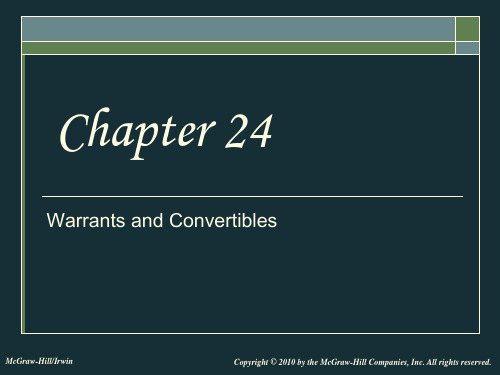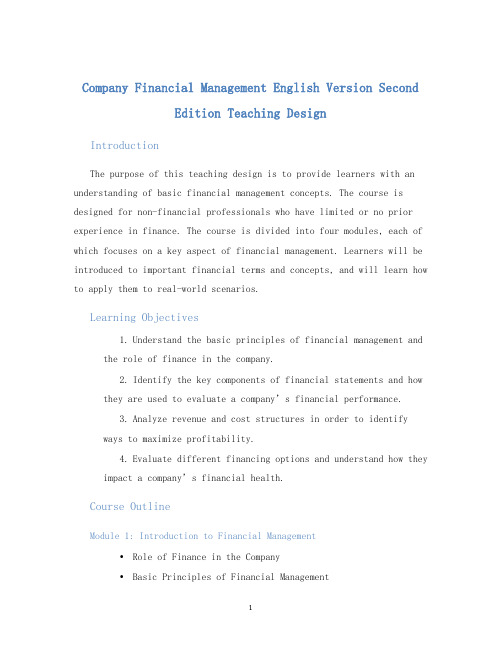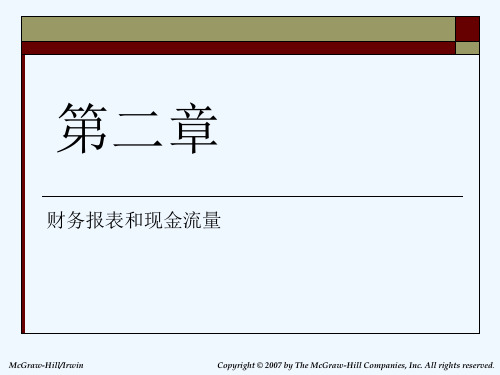公司理财英文版第二章
《公司理财》斯蒂芬A罗斯英文》PPT课件讲义

5.1 Definition and Example of a Bond
• A bond is a legally binding agreement between a borrower and a lender: – Specifies the principal amount of the loan. – Specifies the size and timing of the cash flows:
• In dollar terms (fixed-rate borrowing) • As a formula (adjustable-rate borrowing)
5.1 Definition and Example of a Bond
• Consider a U.S. government bond listed as 6 3/8 of December 2009.
N I/Y PV PMT FV
12
5
– 1,070.52
31.875 = 1,000
1,000×0.06375 2
5.3 Bond Concepts
1. Bond prices and market interest rates move in opposite directions.
2. When coupon rate = YTM, price = par value. When coupon rate > YTM, price > par value (premium bond) When coupon rate < YTM, price < par value (discount bond)
公司理财第二版答案英文版

Company Financial Management Second Edition Answer (EnglishVersion)IntroductionIn this document, we present the answers to the questions and exercises in the second edition of the Company Financial Management textbook. This comprehensive guide aims to provide a better understanding of financial management principles and practices for companies.Chapter 1: Introduction to Financial ManagementQuestion 1: Define financial management and explain its significance for businesses.Financial management refers to the process of planning, organizing, controlling, and monitoring a company’s financial resources to achieve its goals and objectives. It involves making strategic financial decisions that optimize the use of funds and contribute to the long-term success of the business. Financial management is essential for businesses as it allows them to:•Allocate resources efficiently•Minimize financial risks•Maximize profitability and shareholder value•Make informed investment decisions•Ensure regulatory complianceQuestion 2: Describe the three primary areas of financial management.The three primary areas of financial management are:1.Capital Budgeting: This involves evaluating andselecting the best long-term investment opportunities that align with the company’s goa ls. It includes analyzing thepotential returns, risks, and cash flows associated with each investment project.2.Capital Structure: Capital structure refers to themix of debt and equity used to finance a company’soperations. Financial managers need to determine theoptimal capital structure that balances the cost of capitaland the risk of the business. This decision affects thecompany’s ability to raise funds and its overall financialstability.3.Working Capital Management: Working capitalmanagement focu ses on managing the company’s short-term assets and liabilities to ensure smooth businessoperations. It includes managing cash flow, inventory,accounts receivable, and accounts payable effectively tomaintain a healthy liquidity position.Question 3: Explain the goal of financial management.The goal of financial management is to maximize shareholder wealth or value. Financial managers aim to make decisions that increase the market value of the company’sshares and generate higher returns for shareholders. This objective is accomplished by making sound financial decisions, such as investing in profitable projects, optimizing the capital structure, and efficiently managing working capital.Chapter 2: Financial Statements and AnalysisExercise 1: Analyzing Financial StatementsUsing the financial statements for Company XYZ provided below, answer the following questions:Income Statement:Year 1Year 2Revenue$500,000$600,000Expenses$300,000$350,000Net Income$200,000$250,000Balance Sheet:Year 1Year 2Assets$800,000$900,000Liabilities$200,000$250,000Equity$600,000$650,000a)Calculate the net profit margin for Year 1 and Year 2.Solution:Net Profit Margin (Year 1) = Net Income (Year 1) / Revenue (Year 1) * 100 = $200,000 / $500,000 * 100 = 40%Net Profit Margin (Year 2) = Net Income (Year 2) / Revenue (Year 2) * 100 = $250,000 / $600,000 * 100 = 41.67%b)Determine the return on equity (ROE) for Year 1 andYear 2.Solution:Return on Equity (Year 1) = Net Income (Year 1) / Equity (Year 1) * 100 = $200,000 / $600,000 * 100 = 33.33%Return on Equity (Year 2) = Net Income (Year 2) / Equity (Year 2) * 100 = $250,000 / $650,000 * 100 = 38.46%c)Calculate the current ratio for Year 1 and Year 2.Solution:Current Ratio (Year 1) = Assets (Year 1) / Liabilities (Year 1) = $800,000 / $200,000 = 4Current Ratio (Year 2) = Assets (Year 2) / Liabilities (Year 2) = $900,000 / $250,000 = 3.6ConclusionIn this document, we provided the answers to selected questions and exercises from the second edition of the Company Financial Management textbook. These answers should help readers enhance their understanding of financial management principles and practices for companies. It is important to note that this document covers only a fraction of the content presented in the textbook and can be used as a supplementary resource for further study.。
公司理财原版英文课件Chap029

Both Firms Have Debt
How Can Shareholders Reduce their Losses from the Coinsurance Effect?
Retire debt pre-merger and/or increase post-merger debt usage.
29-7
Synergy
Suppose firm A is contemplating acquiring firm B. The synergy from the acquisition is Synergy = VAB – (VA + VB) The synergy of an acquisition can be determined from the standard discounted cash flow model: T
29-15
29.7 Friendly vs. Hostile Takeovers
In a friendly merger, both companies’ management are receptive. In a hostile merger, the acquiring firm attempts to gain control of the target without their approval.
Consolidation
Entirely new firm is created from combination of existing firms
29-4
Acquisitions
公司理财原版英文课件Chap024

24-5
Dilution Example
Firm s value net of debt ' − exercise price # The gain from exercising a warrant can be written as: Firm s value net of debt + exercise price×#w ' − exercise price #+#w
24-6
Dilution Example
Suppose that Mr. Armstrong and Mr. LeMond meet as the board of directors of LegStrong. The board decides to sell Mr. Mercx a warrant. The warrant gives Mr. Mercx the option to buy one share for $1,500. Suppose the warrant finishes in-the-money, (gold increased to $350 per ounce). Mr. Mercx will exercise. The firm will print up one new share.
Chapter 24
Warrants and Convertibles
McGraw-Hill/Irwin
公司理财精要9版-英文-第二章课件

significant loss of value. • Liquid firms are less likely to experience financial distress • But liquid assets typically earn a lower return • Trade-off to find balance between liquid and illiquid assets
$ 400 $ 600 LTD
$ 500 $ 500
700 1,000 SE
600 1,100
1,100 1,600
1,100 1,600
公司理财精要9版-英文-第二章
2-11
Income Statement
• If the balance sheet is like a snapshot, the income statement is like a video recording of what the people did between two snapshot.
公司理财精要9版-英文-第二章
2-3
2.1 The Balance Sheet
• An accountant’s snapshot of the firm。 • It is a convenient means of organization and
summarizing what a fir m owns(its assets), what a firm owes(its liabilities), and the difference between the two(the firm’s equity) at a given point in time. • Assets are listed in order of decreasing liquidity • Balance Sheet Identity(特性)
公司理财英文版第二版教学设计 (2)

Company Financial Management English Version SecondEdition Teaching DesignIntroductionThe purpose of this teaching design is to provide learners with an understanding of basic financial management concepts. The course is designed for non-financial professionals who have limited or no prior experience in finance. The course is divided into four modules, each of which focuses on a key aspect of financial management. Learners will be introduced to important financial terms and concepts, and will learn how to apply them to real-world scenarios.Learning Objectives1.Understand the basic principles of financial management andthe role of finance in the company.2.Identify the key components of financial statements and howthey are used to evaluate a company’s financial performance.3.Analyze revenue and cost structures in order to identifyways to maximize profitability.4.Evaluate different financing options and understand how theyimpact a company’s financial health.Course OutlineModule 1: Introduction to Financial Management•Role of Finance in the Company•Basic Principles of Financial ManagementModule 2: Financial Statements•Balance Sheet•Income Statement•Cash Flow StatementModule 3: Profitability Analysis•Revenue Streams•Cost Structures•Break-Even AnalysisModule 4: Financing Options•Equity Financing•Debt Financing•Capital StructuringTeaching MethodologyThis course will primarily be delivered through a combination of lectures, case studies, and group discussions. Learners will be given supplemental reading materials and will be expected to actively participate in class discussions.AssessmentStudents will be assessed on their understanding of key concepts through the completion of assignments, quizzes, and a final exam. The final exam will be comprehensive and will cover material from all four modules.ConclusionAt the end of this course, learners will have a basic understanding of financial management and the role of finance in the company. They will be able to analyze financial statements, evaluate profitability, and understand different financing options. These skills will enable learners to make informed business decisions and contribute to their company’s financial success.。
公司理财原版英文课件Chap028

Cost Effects
28-8
Example: Evaluating a Proposed Policy – Part I
Your company is evaluating a switch from a cash only policy to a net 30 policy. The price per unit is $100, and the variable cost per unit is $40. The company currently sells 1,000 units per month. Under the proposed policy, the company expects to sell 1,050 units per month. The required monthly return is 1.5%. What is the NPV of the switch? Should the company offer credit terms of net 30?
0 = -50 + (1 - )(110)/(1.01) = .5409 or 54.09%
28-14
Example:
NPV = -v + (1-)(P – v)/R In the previous example, what is the NPV if we are looking at repeat business? NPV = -50 + (1-.15)(110 – 50)/.01 = 5,050 Repeat customers can be very valuable (hence the importance of good customer service) It may make sense to grant credit to almost everyone once, as long as the variable cost is low relative to the price If a customer defaults once, you don’t grant credit again
罗斯公司理财第二章财务报表和现金流量

电子数据收集分析与检索系统 (EDGAR)
10K和10Q报告
2.1 资产负债表
会计师在某一特定时点对企业的会计价值 所拍摄的一张快照
资产负债表恒等式为: 资产 ≡ 负债 + 股东权益
美国 Composite公司(U.S.C.C.)资产负债表
流动资产: 现金和等价物 应收账款 存货 其它 流动资产合计
企业的税负是多少? 平均税率是多少? 边际税率是多少?
如果你正在考虑一个项目,它将增加企业1 百万美元的应税所得,在你的分析中适用 何种税率?
$2,262 1,655
327 90
$190 29
$219 49
$170 84
$86 $43 $43
U.S.C.C.损益表
常用一个单独的 部分报告针对利 润征收的所得税 额。
营业总收入 销货成本 销售、行政和管理费用 折旧 营业利润 其他收入 息前税前利润 利息费用 税前利润 所得税
当前:$71 递延:$13 净利润 留存收益增加 股利:
本章目录
2.1 资产负债表 2.2 损益表 2.3 所得税 2.4 净营运资本 2.5 财务现金流量 2.6 会计现金流量表
资料来源
年度报告
华尔街日报(Wall Street Journal)
互联网
纽约证券交易所 () 纳斯达克 () 教科书 ()
收入 – 费用 ≡ 利润
U.S.C.C.损益表
损益表的经营活 动部分报告企业 来自主营业务的 收入和费用。
营业总收入 销货成本 销售、行政和管理费用 折旧 营业利润 其他收入 息前税前利润 利息费用 税前利润 所得税
当前:$71 递延:$13 净利润 留存收益增加 股利:
- 1、下载文档前请自行甄别文档内容的完整性,平台不提供额外的编辑、内容补充、找答案等附加服务。
- 2、"仅部分预览"的文档,不可在线预览部分如存在完整性等问题,可反馈申请退款(可完整预览的文档不适用该条件!)。
- 3、如文档侵犯您的权益,请联系客服反馈,我们会尽快为您处理(人工客服工作时间:9:00-18:30)。
US Corporation Income Statement – Table 2.2
Insert new Table 2.2 here (US Corp Income Statement)
2-19
Hale Waihona Puke Income Statement Analysis
• There are three things to keep in mind when analyzing an income statement:
2-13
• Which one of the following is included in a firm's market value but yet is excluded from the firm's accounting value? A. real estate investment B. good reputation of the company C. equipment owned by the firm D. money due from a customer E. an item held by the firm for future sale
• Which one of the following accounts is the most liquid? A. inventory B. building C. accounts receivable D. equipment E. land
• Which one of the following represents the most liquid asset? A. $100 account receivable that is discounted and collected for $96 today B. $100 of inventory which is sold today on credit for $103 C. $100 of inventory which is discounted and sold for $97 cash today D. $100 of inventory that is sold today for $100 cash E. $100 accounts receivable that will be collected in full next week
US Corporation Balance Sheet – Table 2.1
Place Table 2.1 (US Corp Balance Sheet) here
2-12
Market Value vs. Book Value
• The balance sheet provides the book value of the assets, liabilities, and equity. • Market value is the price at which the assets, liabilities ,or equity can actually be bought or sold. • Market value and book value are often very different. Why? • Which is more important to the decisionmaking process?
Debt versus Equity
• Creditors generally receive the first claim on the firm’s cash flow. • Shareholder’s equity is the residual difference between assets and liabilities.
Shareholders' equity:
A. increases in value anytime total assets increases. B. is equal to total assets plus total liabilities. C. decreases whenever new shares of stock are issued. D. includes long-term debt, preferred stock, and common stock E. represents the residual value of a firm.
• Dee Dee's Marina is obligated to pay its creditors $6,400 today. The firm's assets have a current market value of $5,900. What is the current market value of the shareholders' equity? A. -$600 B. -$500 C. $0 D. $500 E. $600
Example 2.2 Klingon Corporation
KLINGON CORPORATION Balance Sheets
Market Value versus Book Value
Book Assets NWC NFA $ 400 700 1,100 Market Book Market
2-2
Chapter Outline
• • • • The Balance Sheet The Income Statement Taxes Cash Flow
2-3
Balance Sheet
• The balance sheet is a snapshot of the firm’s assets and liabilities at a given point in time • Assets are listed in order of decreasing liquidity
• Know the difference between book value and market value • Know the difference between accounting income and cash flow • Know the difference between average and marginal tax rates • Know how to determine a firm’s cash flow from its financial statements
• Liquidity
– Ability to convert to cash quickly without a significant loss in value – Liquid firms are less likely to experience financial distress – But liquid assets typically earn a lower return – Trade-off to find balance between liquid and illiquid assets
2-5
Net Working Capital and Liquidity
• Net Working Capital
– = Current Assets – Current Liabilities – Positive when the cash that will be received over the next 12 months exceeds the cash that will be paid out – Usually positive in a healthy firm
2-6
• Which one of the following will increase the value of a firm's net working capital? A. using cash to pay a supplier B. depreciating an asset C. collecting an accounts receivable D. purchasing inventory on credit E. selling inventory at a profit
– Ease of conversion to cash – Without significant loss of value
• Balance Sheet Identity
– Assets = Liabilities + Stockholders’ Equity
2-4
The Balance Sheet - Figure 2.1
• You recently purchased a grocery store. At the time of the purchase, the store's market value equaled its book value. The purchase included the building, the fixtures, and the inventory. Which one of the following is most apt to cause the market value of this store to be lower than the book value? A. a sudden and unexpected increase in inflation B. the replacement of old inventory items with more desirable products C. improvements to the surrounding area by other store owners D. construction of a new restricted access highway located between the store and the surrounding residential areas E. addition of a stop light at the main entrance to the store's parking lot
